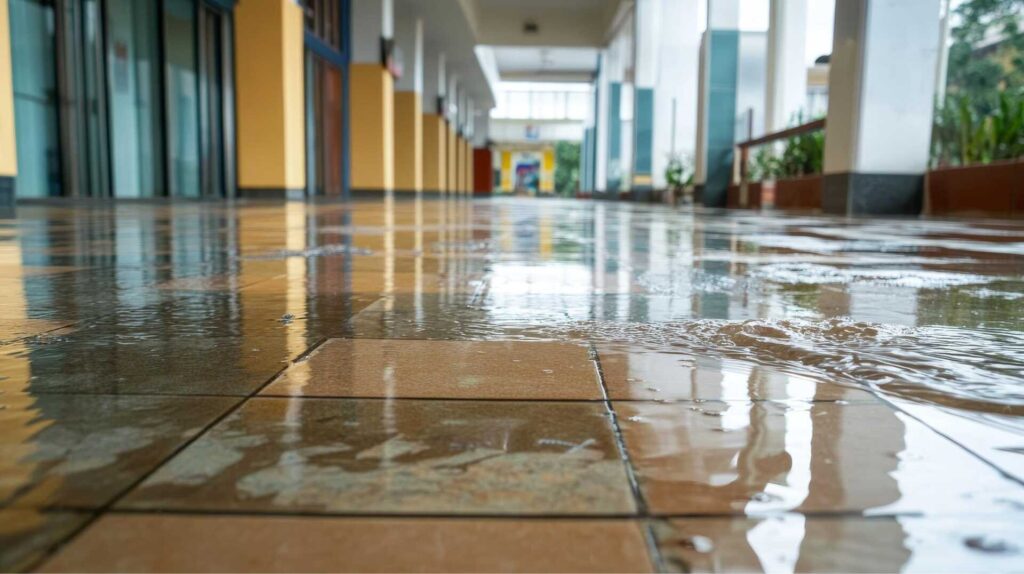
Contents
When you’re faced with commercial water damage, your initial steps can significantly influence the restoration process’s efficiency and outcome. First, you’ll want to assess the damage promptly—speed is crucial to mitigate further deterioration. Document every detail meticulously; this isn’t just for your records, but it’s essential for handling insurance claims smoothly. Then, you must choose the right water extraction techniques. Knowing whether you’re dealing with clean water, gray water, or black water will determine the equipment you use. But what about drying? There’s a strategic approach to it that speeds up the process and ensures you’re not left with lingering issues like mold. What might that involve?
Key Takeaways
- Quickly assess damage and document all affected areas to streamline insurance claims.
- Utilize appropriate water extraction techniques based on the type of water involved.
- Implement effective drying strategies using suitable dehumidifiers and moisture meters.
- Begin drying processes within 24-48 hours to prevent mold growth.
- Maintain constant communication with insurance for efficient claims processing and coverage verification.
Assessing the Damage Quickly
When addressing commercial water damage, it’s crucial to assess the extent of the damage quickly. This initial damage evaluation sets the stage for a swift recovery, minimizing operational disruptions and financial losses.
You’re not just dealing with property damage; you’re managing an event that affects your team and your future operations.
Start by documenting everything. Take photos, jot down notes, and list all affected areas. This thorough documentation is vital for your records for your insurance claims.
Accurate and detailed records can speed up the claims process significantly, ensuring you receive the necessary funds to cover the repairs.
Next, determine the safety of the structure. Water damage can compromise building materials, leading to potential hazards. It’s important to have a professional evaluate the integrity of the building.
You should not handle this on your own; it’s about the safety of everyone who enters your premises.
Contact your insurance company as soon as possible. Early communication can facilitate a smoother claims process.
Provide them with all the documentation you’ve gathered. Be prepared to answer questions about the damage and how it occurred.
Being proactive in your communications can help establish a cooperative relationship with your insurer, which might ease the overall process.
Implementing Water Extraction Techniques
After assessing the damage, it’s crucial to begin extracting water to prevent further deterioration of your property. As you embark on this vital step, understanding the most effective water removal methods and the best equipment selection is key to mitigating damage swiftly and efficiently.
Firstly, identify the type of water you’re dealing with—clean, gray, or black. This classification impacts the equipment and safety measures you’ll need. For clean and gray water, portable extractors and submersible pumps are typically sufficient. These devices are designed to remove water quickly and are relatively easy to handle, ensuring that you can start the process without delay.
Consider a truck-mounted extractor for more severe scenarios involving black water, which may contain hazardous contaminants. This equipment is more powerful and can handle larger volumes of water and contamination, making it ideal for extensive commercial spaces.
Incorporate wet vacuums into your arsenal for areas that are difficult to reach with larger equipment. Wet vacuums can efficiently suck up water from carpets and corners, which is crucial for thorough water removal.
When selecting equipment, always opt for industrial-grade tools that can withstand the demands of large-scale water extraction. These tools are more robust and can operate for extended periods, which is essential in a commercial setting.
Strategies for Effective Drying
Having extracted the water, shifting your focus to drying your property effectively is crucial to prevent mold growth and structural damage. You’re not alone in this—every step you take is a move towards restoring the heart of your business. Let’s dive into the essentials of dehumidification methods and moisture monitoring, tools that’ll ensure you’re on the right track.
Dehumidification isn’t just about plugging in a machine; it’s about selecting the right approach for your space. There are primarily two types of dehumidifiers: refrigerant and desiccant. Refrigerant dehumidifiers work best in warm, humid conditions as they cool air to remove moisture. Desiccant dehumidifiers, on the other hand, use chemicals to absorb moisture and can operate effectively across a broader range of temperatures and humidity levels.
Here’s a quick guide on choosing the right dehumidifier:
| Type | Best Use Case |
|---|---|
| Refrigerant | Warm environments; high moisture levels |
| Desiccant | Cooler environments; varying humidity |
Moisture monitoring is equally crucial. You’ll want to use moisture meters to check the content in walls and floors to determine the effectiveness of your drying process. This isn’t just about hitting benchmarks; it’s about ensuring every part of your property is uniformly dry to prevent uneven drying and structural issues.
| Tool | Function |
|---|---|
| Moisture Meter | Assess moisture levels in various materials |
Summary
As you wrap up your restoration, picture your commercial space returning to its pre-damage splendor. You’ve quickly assessed the damage, harnessed the best extraction gear for rapid water removal, and strategically deployed dehumidifiers to banish every hint of moisture. By following these steps meticulously, you ensure a swift, thorough recovery, safeguarding your property’s integrity and preventing future issues. Remember, the effectiveness of your response today dictates the resilience of your business tomorrow.
Recent Posts
What Are Emergency Water Removal Services?
Imagine water pooling in your living room, threatening to damage your cherished belongings and compromise
How to Remove Water From Flooded Basements
Flooded basements affect nearly 14 million homes in the U.S. each year, making effective water
Your Guide to 24/7 Emergency Water Damage Repair
Did you know that the initial 48 hours after water damage are critical in preventing
